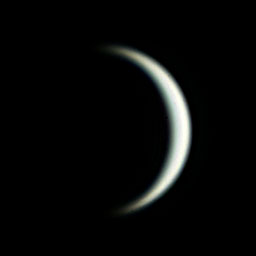Today Jupiter passes through superior conjunction, passing behind the Sun as seen from our vantage point here on Earth. The planet is currently lost in the Sun’s glare and unobservable, it will reappear in the dawn sky during the first week of August.
Tag: Jupiter
Jupiter Exits the Evening Sky

The Moon and Jupiter
This evening a very thin crescent Moon will meet Jupiter low in the sunset glow. Only 3.4% illuminated the Moon will be 6° west of a bright Jupiter. About 16° above the horizon at sunset, the Moon will set at 20:14HST with Jupiter setting a few minutes later at 20:20HST. The two should create a striking pair in the rosy glow of dusk.
The Moon and Jupiter
This evening the Moon and Jupiter will be close. The two will be visible in the sky throughout the day becoming a striking pair as the sky grows dark. The Moon will be 11% illuminated and about 6° from the bright planet at sunset.
Mercury should be visible 18° below Jupiter, a 1.3 magnitude object lower in the sunset glow.
The Moon and Jupiter
This evening the Moon and Jupiter will be close. The two will be visible in the sky throughout the day becoming a striking pair as the sky grows dark. The Moon will be 23% illuminated and about 7° from the bright planet. Tomorrow night the pair will still be close, about 9.5° apart.
The Moon and Jupiter
Tonight the Moon and Jupiter will be close. The Moon will rise first, at 10:56HST, most of an hour ahead of Jupiter, placing the two quite high in the sky at sunset. The Moon will be 39% illuminated and about 10° from the bright planet. Tomorrow night the pair will be much closer, about 6.5° apart.
The Moon and Jupiter
Tonight the Moon and Jupiter will be close. The Moon will rise first, at 13:04HST, about ten minutes ahead of Jupiter, placing the two well up in the eastern sky by sunset. The Moon will be quite large, 65% illuminated and about 6° from the bright planet. Tomorrow night the pair will still be seen together, about 11° apart.
With Jupiter this close to the Moon it is an excellent time to see Jupiter in the daytime sky. Look 6° northeast of the Moon for a bright pinpoint of light. 6° is 12 times the size of the Moon seen in the sky, north will be to the left seen as the pair rises above the eastern horizon.
The Moon and Jupiter
Tonight the Moon and Jupiter will be quite close. The pair will rise at nearly the same time, about 15:09HST, placing the two well up in the eastern sky by sunset. The Moon will be quite large, 87% illuminated and about 5° from the bright planet.
With Jupiter this close to the Moon it is an excellent time to see Jupiter in the daytime sky. Look 5° north of the Moon for a bright pinpoint of light. 5° is ten times the size of the Moon seen in the sky, north will be to the left seen as the pair rises above the eastern horizon.
Seeing Planets in the Daytime Sky
We expect to wait until darkness falls to observe the stars and planets. While the Sun and Moon are normally seen in the daytime sky, there are other objects that may be observed.

Both Jupiter and Venus are bright enough to see fairly easily in full daylight if conditions are right. Saturn can be observed with a telescope if you can locate it. Very occasionally, we are treated to a daytime visible comet.
Jupiter and Venus are the easiest, you simply need to know where and how to look, but once glimpsed they are fairly easily seen. It is the knowing how that makes it possible. Try these simple hints…
- Try when the planets are far from the glare of the Sun, in the first hours after dawn or last hours of the day are best.
- Clean air is necessary. If the air is hazy, dusty or smoggy it will hide the planets from view, particularly when near the Sun. There will just be too much solar glare to pick out the planet. For the same reason try when the planet is high in the sky and you are looking through much less air.
- The human eye will relax and defocus if there is nothing to focus on. This happens when looking at a plain expanse of blue sky. You could be looking right at the planet and not see it. A few puffy clouds around, or better yet, the Moon, will give the eye something to focus on, allowing the planet to be easily seen.
- Put the Sun out of sight to reduce glare. Simply position yourself in the shadow of a tree or building to get a better view.
- Pick a day when the Moon is near the object you are looking for, it will provide a simple signpost to the correct location.
It is this last hint that can be particularly useful. Looking ahead with the aid of a planetarium program you can find a day when the Moon is near the planet. Using the program to estimate the position with respect to the Moon you can look in just the right place. If you get it right the planet will appear as a bright star-like object. Once you see it you will wonder how you ever missed it in the first place.
Have a try.
The Moon and Jupiter
Tonight the Moon and Jupiter will be quite close. The pair will rise at nearly the same time, about 17:08HST. The Moon will be very near full, 98% illuminated and about 5° from the bright planet.
